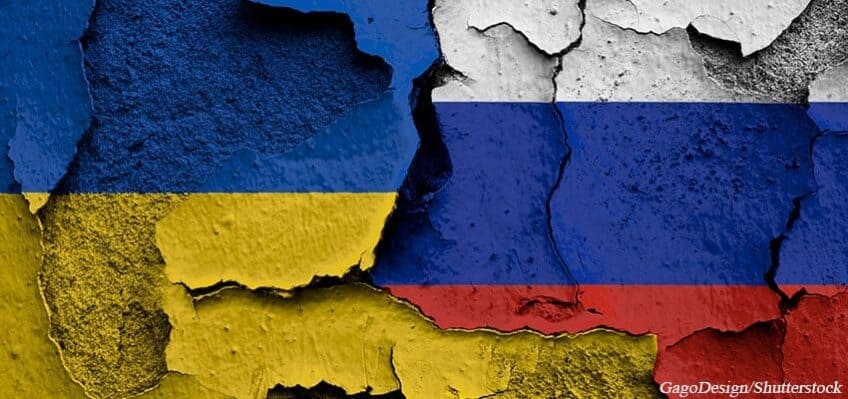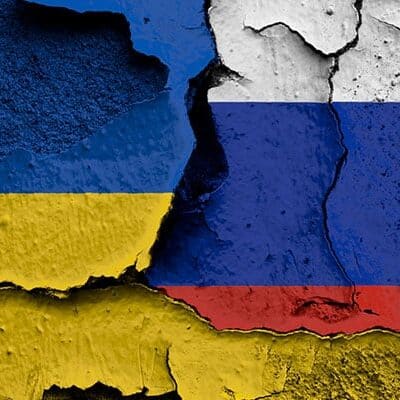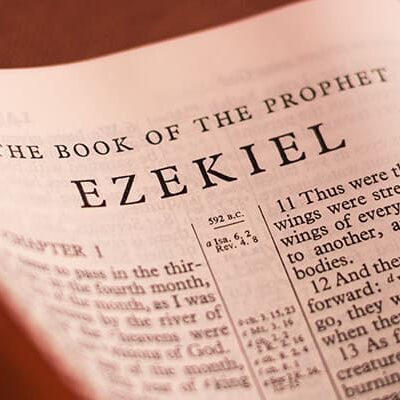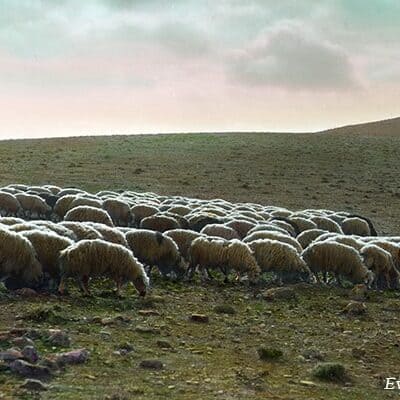The current Russian-Ukrainian conflict has re-ignited an interest in the Biblical origins of the peoples of Russia.
President Putin has appealed to history in an attempt to convince the Ukrainians and Byelorussians that they, together with the Great Russians (Meshech and Tubal), are the same people and should unite.
Is this true? Are they the same people or rather similar people that live adjacent to one another? We shall see. For example, the Ukrainians have been separate for a longer period than they have been united with the Great Russians. Is it possible that the current configuration of the peoples located in and near the western portion of Russia can extend back to their original homeland in the ancient Middle East, in a roughly similar configuration?
In this article we explore the peoples of Rosh mentioned in the Scriptures and their likely modern-day location. Do they reside alongside other nations resident within Russia and former Soviet Union republics? The other peoples of Russia, Ukraine and the Baltic states are covered in detail in my book In Search of … the Origin of Nations (chapters 8, 12).
The Ancient Mitanni
Let us commence the search for the origin of the Rosh and surrounding peoples with Abraham – you will come to see the logic of that as we journey through this study.
Abraham had a concubine, Keturah (see Gen 23:2; 25:1, 6; I Chron 1:32). Jamieson, Fausett and Brown’s Commentary Critical and Explanatory on the Whole Bible (1871) states: “Abraham took a wife — rather, “had taken”; for Keturah is called Abraham’s concubine, or secondary wife (1 Ch 1:32); and as, from her bearing six sons to him, it is improbable that he married after Sarah’s death; and also as he sent them all out to seek their own independence, during his lifetime, it is clear that this marriage is related here out of its chronological order, merely to form a proper winding up of the patriarch’s history.” Refer also to Adam Clarkes Commentary on the Bible (1817), Keil & Delitzsch’s Commentary on the Old Testament (1861 ff) and a number of other specialists.
Sons, grandsons and great-grandsons of Abraham from his union with Keturah:
•Zimran
•Jokshan -Sheba
-Dedan -Asshurim
-Letushim
-Leummim
•Medan
•Midian -Ephah
-Epher
-Hanoch
-Abidah
-Eldaah
•Ishbak
•Shuah
These were sent to the east country apparently around the northern portions of the Euphrates (Gen 25:6). The descendants of Abraham through Keturah would have settled in the region of the Caucasus, both north and south of the mountain range.
After multiplying greatly, they came pouring down into Anatolia and northern Mesopotamia (with some settling south of Edom in northwest Arabia), becoming known at that time as the Hurrians (Leonard Cottrell, The Concise Encyclopedia of Archaeology, p. 178). One branch of Hurrians were known as the Mitanni and their rulers the Maryanni. They were evidently named after their forefather Midian.
The Mitanni were of the White branch of the Indo-Europeans (Arthur Basham, The Wonder that was India, p. 29) with their fair skin and often-times blonde hair. The bust of Queen Nefertiti (a Midianitess) and the wife of Pharoah Amenohotep IV, reveal her features and facial type as clearly Nordic (Ayyaswami Kalyanaraman, Aryatarangini. The Saga of the Indo-Aryans, Vol. 1, p. 79). It may be significant that the first god they invoked is the Vedic Sun-god, Mitra or Mithra which may have been Midian himself deified.
Their royal names reflected their worship of the Aryan deities and they possessed specialised knowledge of horse-breeding like their relatives in north-west India (Kalyanaraman, ibid, p. 178). One of their gods was Teshub, the god of battles, with his thunderbolt in his hand; he was later called Thor in Europe. Like the Hittites, their relatives, historians acknowledge that they were a warlike people.
What became of these mysterious Mitanni after their kingdom fell c1400 BC? Haddon comments, “The ‘Aryans’ of Mitanni were called by the Greeks Mattienoi; they are possibly the ancestors of the modern Kurds.” (Alfred Haddon, The Wandering of Peoples, p. 21)
Indeed, the Kurds (living in the same area as the ancient Mitanni) may well be the mixed remnant of Arabic peoples with the Mitanni and Hittites. But what of those which did not mix and remain in the area? Of them, Cappieri notes that “nothing more is heard of them; they disappear in unknown India.” (Mario Cappieri, The Mesopotamians of the Chalcolithic and Bronze Ages, p. 152)
If so, where are they located today?
The Land of Rashu
A famous prophecy in the book of Ezekiel speaks of a ruling class over the Great Russians (Meschech and Tubal):
“Son of man, set thy face against Gog, the land of Magog, the chief prince of Meschech and Tubal” (Ezekiel 38:2 KJV).
The question arises whether the word Rosh, here translated “the chief prince,” is a description or a proper name. In this regard I would recommend “Rosh: An Ancient Land known to Ezekiel,” Grace Theological Journal, Vol. 6, No. 1, 1985, pp. 67-89 by James Price. Price uses linguistic methodologies to convincingly argue that the Hebrew word for Rosh in Ezekiel is a name, not merely a description. It does refer to a people (and no doubt the leader of those people) hence, Price argues, the correct translation for Ezekiel 38:2-3; 39:1 is “prince of Rosh, Meshech, and Tubal.”
The marginal note for this verse reads “or, Prince of the chief”. The translators derived this from Jerome’s Latin Vulgate which read “Principem Capitis”, because the Hebrew word for “chief prince” is “Ro’sh” (Ethelbert Bullinger, The Companion Bible, p. 1161), meaning “head” or “leader” (Bullinger, ibid). The Septuagint rendering is “Ruler of Rosh.”
You may search the Scriptures from one end to the other, and you will find only one Rosh mentioned, and that is in Genesis where he was a son of Benjamin (Genesis 46:21), one of ten brothers. When we come to the book of Numbers, only five brothers are mentioned (Numbers 26:38; see I Chronicles 8:1-2). Later, in I Chronicles, only three are referred to (I Chronicles 7:6). Why? Either because their line had become extinct (Bullinger, ibid, p. 540), or because they had migrated outwards as they were, by instinct, a pioneering, adventurous and exploring people. The tribe of Benjamin, or rather a part of it, was possibly in Asia Minor at some stage (Herbert Hannay, European And Other Race Origins, p. 246) and if so, probably dwelt with the Mitanni. Both because the Mitanni were blond and/or because Rosh lived with them, the Kingdom of Mitanni became known as the “land of Rashu,” Rash or Rosh meaning “blond” (James Orr (ed) The International Standard Bible Encyclopedia, Article “Rosh”).
Several years ago an alert contact of mine came across an article, “Othniel, Cushan-Rishathaim, and the Date of the Exodus”, Artifax, Summer 2017, pp. 14-20 by Clyde Billington, based on Judges 3:7-11 which mentions Cushan-Rishathaim. I was most grateful for him sending the article to me as it not only confirmed my studies, but also added additional valuable facts. Below are pertinent extracts from this important article:
“While King Cushan is not mentioned in other known historical sources, his people the Rishathaim are referred to in a number of ancient texts. The Rishathaim are identified with an ancient people better known to historians today as the Mitanni … The Rishathaim are mentioned in a variety of ancient sources. An inscription from the reign of Hatshepsut [ruled ca. 1518-1482 B.C.] mentions the ‘Country of Reshet.’” (p. 14)
“The Rishim people can be connected to the Kingdom of Mitanni in a rather strange way. An ancient people called the ‘Rsi’ conquered northern India sometime before ca. 1300 B.C. The exact date for the Rsi invasion into India is not known. However, it is known that the great Indus Civilization began to disappear in the 17th Century B.C., and it is also known that an ‘Indo-Aryan’ race replaced the native peoples of the Indus Civilization in the Indus Valley. Indo-Aryans are a branch of the Indo-European peoples …
“The modern Indian historian and ethnologist Ramaprasad Chanda in his book The Indo-Aryan Races (Chandra, 1969, p. 180) writes that the Rsi people were a ‘Fair-haired’ people who invaded India ‘from the far north.’ Thutmosis III is known to have brought blond captives back to Egypt from his campaigns to the north against the Mitanni in the 15th Century BC.” (p. 15)
“… A variety of other ancient sources strongly suggest that they called themselves something like the ‘Rish’ or by variants of that name such as ‘Teresh’ and ‘Reshet.’ It is nearly certain that these Rish people did not originally call themselves Mitannians.” (p. 16)
“The historical and textual evidence also suggests that the Indo-Aryan ethnic group that founded and ruled Mitanni called themselves originally by a name that sounded something like ‘Rish’ or ‘Ras.’ This name is reflected in Judges 3:7-11 where Cushan is said to have been from an ethnic group called the ‘Rishathaim.’” (p. 19) [emphasis mine]
But where are these Rosh today?
Herodotus (c484-425BC) indicated that the Matienians were with the peoples of Tubal and Meschech (The Histories, Book 3 (Thalia), Chapter 94); while centuries later, Pliny (c23-79AD) wrote of the Matiani as if in the direction of southern Russia over the Caucasus (The Natural History, Book 6, Chapter 18, Sections 17-18). Herodotus also wrote about “the Matieni … The Moschi, Tibareni, Macrones, Mossynoeci …” [emphasis mine]. Dr. Gesenius in his meticulous Hebrew and English Lexicon maintains that,
“Rosh was a designation for the tribes then north of the Taurus Mountains, dwelling in the neighbourhood of the Volga” (Wilhelm Gesenius, Hebrew And English Lexicon of the Old Testament, pp. 534, 626, 955, 1121).
He concluded that in this name we have the first trace, historically, of the Rus or Russian state.
Another scholarly work worth a read is “An attempt to interpret some Anatolian and Caucasian ethnonyms of the classical sources,” Sprache und Kultur, No. 3, pp. 68-83 by Giorgi Kavtaradze. In this work he painstakingly demonstrates how peoples known as the Mosche (Mesches), Tibareni and Mossynoeci were living in proximity to the Matienians as neighbours in the ancient world (pp. 79-80). Don’t these names sound familiar and possibly be identifiable with Biblical names in Ezekiel 38? These peoples migrated into the region we call Russia and dwell there alongside each other to this day, in a similar configuration to when they lived contiguous to each other in the ancient Near East.
Rosh – The Original Russians
The German scholar, Dr. Keil, after very thorough grammatical analysis of Ezekiel 38:2-3 states that the word translated “chief prince” should be correctly rendered as a proper name, Rosh. He says that many Arabic and Byzantine writers frequently mention a people which they call Ros or Rus dwelling among certain Scythian tribes in the country of Taurus (Carl Keil, Biblical Commentary on the Prophecies of Ezekiel, Vol. 2, pp. 159-60). Another researcher, Victor Kachur, in one of his works, makes mention of the Rusi who were in southern Russia; they claimed that many of their tribe were living with the Cimmerian Scythians (Victor Kachur, The Trans-Caucasion Migration of the Rusi Tribes, pp. 5, 7). Interestingly, Bowle maintains that although the name Rus is a Norse word, there is enough evidence that it is of Iranian origin (John Bowle, The Concise Encyclopedia of Archaeology, p. 154). After all, the Mitanni-Rosh originally dwelt on the border of ancient Iran and spoke the Aryan/Iranian tongue.
What does Rus mean? It probably means ‘blond.’ Byelorussia, also spelt Belorussia and sometimes known as White Ruthenia, is situated close to the Baltic peoples. According to Lubachko, the name of Belaia Rus or Belarus derives from the fact that they are a people with light-coloured hair (Ivan Lubachko, Belorussia Under Soviet Rule, 1917-1957, p. 1) though views differ as to the origin of the name.
The meaning of names can, after all, evolve and change over time. And even transfer to a different people.
The Varangian Rus
The origins of Russia are related in the Chronicle of Nestor or Russian Primary Chronicle which was written in Pechersky Monastery of Kiev toward the end of the 11th century, placing the following event in 862 AD. Of these tribes it says:
“Among them there was no law, and tribe rose up against tribe, and there were feuds among them, and they began to fight each other. And they spoke among themselves: ‘We must find a prince who will rule justly over us’. And they crossed the sea to the Varangians, the Rus, for the Varangians were called Rus, as others are called Swedes, others Norwegians and Anglians, others Gotlanders, thus also these men. The Chaudes, Slovenes, Krivichi and Vesses said to these Rus, ‘Our land is great and rich, yet there is no order in it. Come therefore and rule over us.’” (quoted in Hilda Davidson, The Viking Road to Byzantium)
They knew that these peoples possessed apparent leadership and administrative qualities. Who could their ancestors be? Professor Hannay explains that the tribe of Benjamin, or a part of it, migrated into Scandinavia (Herbert Hannay, European And Other Race Origins, pp. 465-66). No wonder that area of Russia south of the Baltic Sea became known as “Swithiod the Great” or “Sweden the Great.” Thus it is speculated by Edwin Yamauchi that the Vikings gave the name of Rus to the White Russians (Foes from the Northern Frontier, p. 20). But as we shall see, the appelation of Rus was already in use by tribes in southern Russia.
While western scholars accept this as the origin of the Rus, Soviet scholars contended that the Rus were Slavs from the southern steppes (Yamauchi, ibid, p. 21. See also Nicholas Riasonovsky “The Norman Theory of the Origin of the Russian State”, The Russian Review, Vol. 7, No. 1, pp. 96-110). Both are probably correct as there is no evidence of a tribe from Scandinavia called Ros or Rus, but a tribe of the Antes was known as the Ros and later modified to Rus which resided along the river Ros, a tributary of the Dnieper in the southern Ukraine, just north of the Black Sea (Dennis Elliott, “The Origin of Russia”, The Testimony, May 1993, pp. 175-78).
In 1613 AD Mikhail I founded the Romanov dynasty until the Communist revolution in 1917. It should be mentioned that Mikhail’s first wife was a Rurik but she bore him no children. Later, the German-born Catherine the Great took the throne – she was partially of Rurik stock. After they had completed their work in White Russia, the mass of these eastern Vikings later returned to Scandinavia (Bertil Lundman, “The Racial History of Scandinavia,” The Mankind Quarterly, 1962, Vol. 3, No. 2, p. 4), their royal house remaining in Russia and probably intermarrying with the White Russians (Belorussians).
Prophetically, nothing much is said about Midian. Perhaps the peoples in the book of Judges where they are allies of the Amalekites (Gog), are a type of the future pre-Millennial eastern hordes (Judges 7:12. Cp Rev. 16:12). Through Habbakuk, God says that the Midianites (the Mitanni) will tremble at Him when He begins to intervene in world affairs (Habbakuk 3: 7-8). They are also referred to prophetically in Jeremiah 25:25. In Ezekiel 38:1-6 the Rosh are mentioned in context of leading a rebellion during the early years of Christ’s Millennial reign.
In Part Two we will trace the migrations of Midian’s brother’s descendants from their original homeland in the Middle East to their modern locations.










